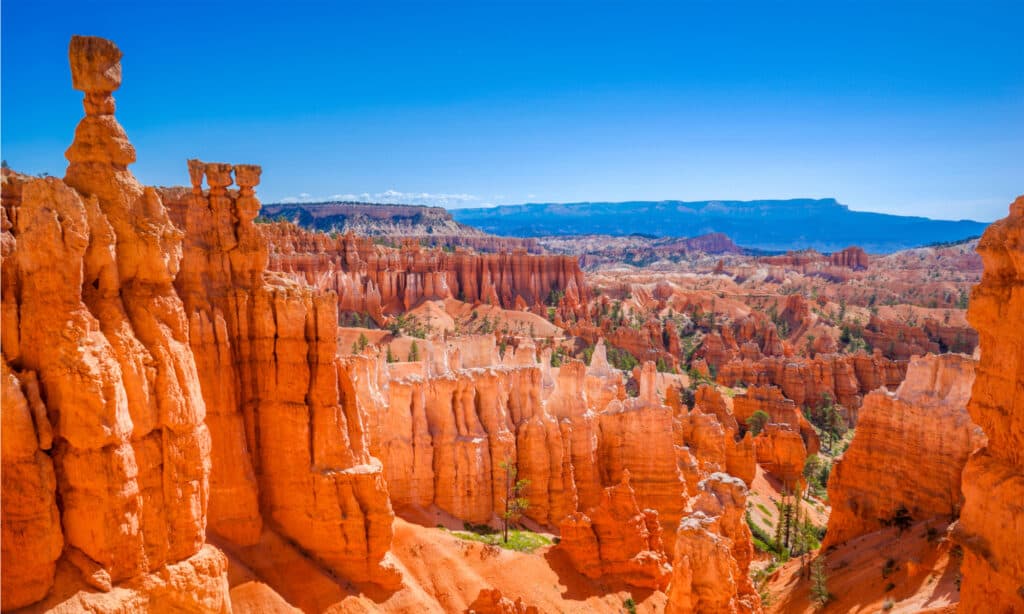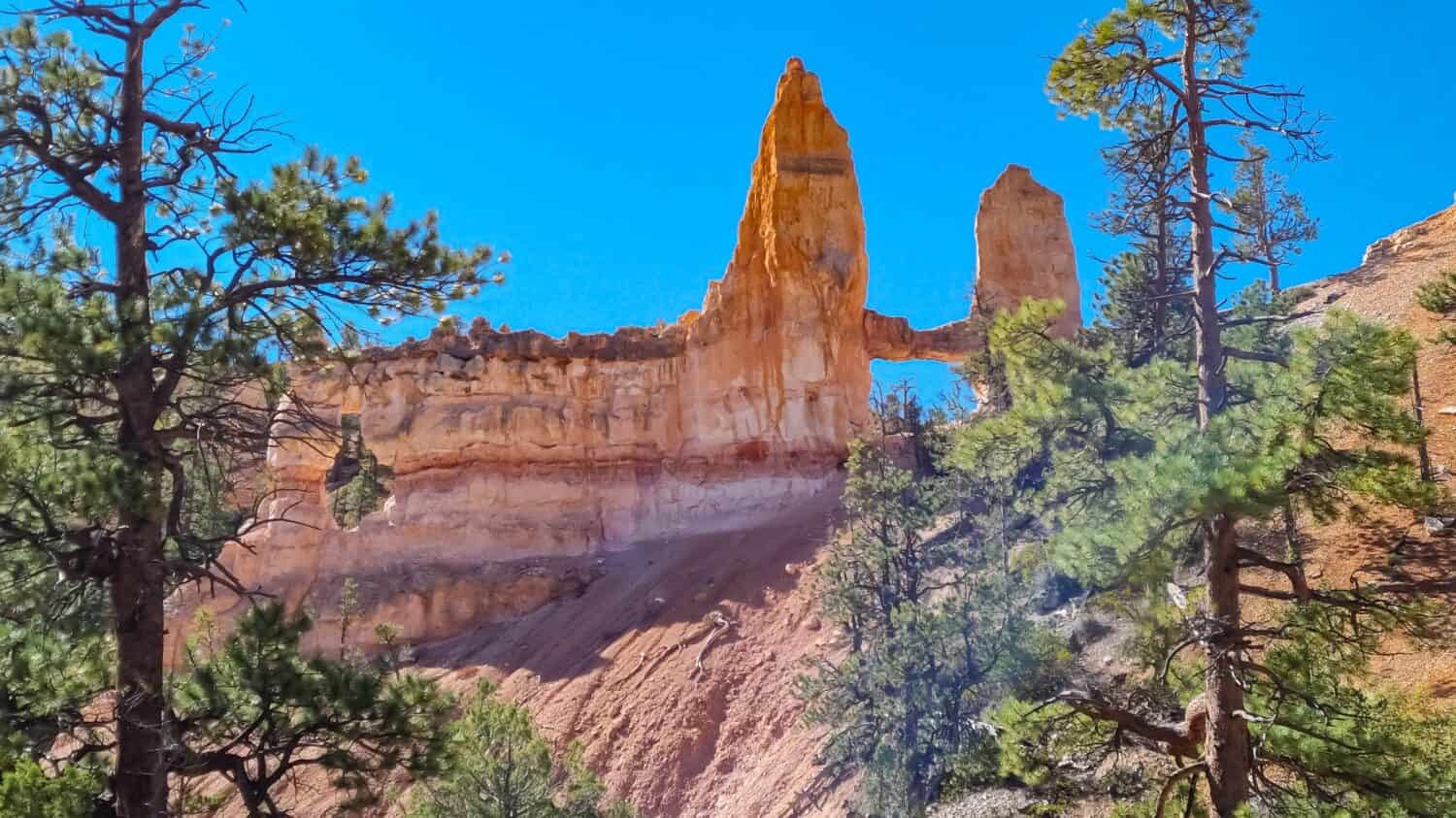The magnificent natural arches and recognizable hoodoo rock formations of Bryce Canyon National Park are its most famous features. Bryce Canyon formed roughly 50 million years ago when weather-related forces took over the area.
Whether you’re planning a hiking excursion or just love learning about geology, you’re in the right place! Below you’ll discover everything there is to know about this breathtaking plateau and why it’s well worth a visit.
How Was Bryce Canyon Formed?

Precipitation and wind helped form this area.
©silky/Shutterstock.com
A portion of the Paunsaugunt Plateau is Bryce Canyon. Instead of a river, it was actually weather-related factors like precipitation and wind that shaped this plateau. The National Park service researches the natural process that led to the creation of Bryce Canyon and its recognizable hoodoos.
The rocks and minerals that became the limestones, dolostones, mudstones, siltstones, and sandstones that makeup Bryce Canyon’s layers of rock were mixed together by a lake and floodplain network approximately 50 million years ago.
Bryce Canyon was elevated to a point where it was able to experience both above as well as below-freezing temperatures in a single night over the course of millions of years of plate tectonic processes.
Shockingly, this area would experience such weather extremes 170 days of the year. The following stage of Bryce Canyon’s creation, weathering and erosion, was entirely dependent on the weather.
Water sits in the fissures in the rock where it creeps in. When Bryce Canyon experiences freezing conditions hours after the water enters, it becomes confined within the granite and starts to turn into ice. Water swells by 9% when it turns into ice.
The adjoining rock is put under extreme pressure as a result of this expansion of ice, which causes it to crumble. Since the ice is physically pushing the rocks away, this action is referred to as “ice wedging”. The rocks ultimately separate from the plateau and become barriers, openings, and then distinct hoodoos.
Where Is Bryce Canyon Located?

Bryce Canyon is a short drive from Las Vegas.
©Alexander Lukatskiy/Shutterstock.com
Southwest Utah is home to Bryce Canyon, which is less than a five-hour drive from Las Vegas, NV. The surrounding towns of Cannonville or Panguitch are about a 30-minute drive from the National Park, which is located on Utah State Highway 63.
If you’re thinking about combining a getaway to Bryce Canyon into a longer route that also includes visits to other national parks, Zion National Park is less than two hours away. Additionally, the North Rim of the Grand Canyon is approximately three hours away, with the South Rim being another two hours.
Naming a Canyon
Ebenezer Bryce, a skillful carpenter who was dispatched by the Church of Jesus Christ of Latter-Day Saints to the region in the 1870s to assist Mormon pioneers, coined the name Bryce Canyon. The name “Bryce’s Canyon” remained after residents started naming the canyon, which lies close to his house.
Activities in Bryce Canyon
The enchanting Bryce Canyon National Park is popular for its majestic hoodoos, captivating canyons, switchbacking paths, horseback journeys, and magnificent sunsets. The best seasons for touring Bryce Canyon National Park are in autumn when there are fewer visitors and winter when there are fewer visitors and snow-capped hoodoos.
Scenic Drive

There are many wonderful sights to see here.
©Margaret.Wiktor/Shutterstock.com
Cruising the Main Park Road makes for one of the most enjoyable activities to do in Bryce Canyon National Park overall, as well as for anybody who has restricted mobility. From the sign indicating the entrance to the park to the parking area for Rainbow Point, Bryce Canyon Road is 18 miles long and rises around 1,200 feet.
The entire route is above 7,500 feet in height, making it one of the tallest drives in all of the national parks in the country. Without any breaks, the trip takes roughly 30 minutes to complete. You can visit all the major sights, excursions, and panoramas in Bryce Canyon along the route.
Camping

Camping is one of the most popular activities in the area.
©Yury Birukov/Shutterstock.com
Bryce Canyon, which is one of Utah’s premier national parks for camping because of its high altitude, has summer nights that are the perfect temperature for a good night’s sleep. There are 100 spaces in the North Campground that are available to RVs and people camping in tents.
One mile down the road, 100 campsites at Sunset Campground are available for tent and RV campers as well. All of the amenities from North Campground are present at this campground.
With the exception of the group sites, Sunset Campground follows the rule of first-come, first-served, while North Campground operates on a basis of reservations throughout the busy seasons and first come, first served in the off-peak seasons.
Stargazing

One of the best activities here is nighttime stargazing.
©iStock.com/gorodenkoff
One of the best spots in the US to view the stars is Bryce Canyon National Park, which has clear, dry air and almost little light pollution. In Bryce Canyon, on a night of clear skies, you may observe 7,500 stars and 2.2 million light years into the great beyond.
Stargazing in Bryce Canyon National Park is well-known worldwide. Farview Point, Inspiration Point, and Fairyland Point are a few of the top vantage points in Bruce Canyon for viewing the night sky.
Hiking

The Tower Bridge Trail is in Bryce Canyon.
©Christopher Moswitzer/Shutterstock.com
Tower Bridge Trail should be on the agenda of activities to do in this area if you’re searching for a moderate trek with a bit of elevation. This trail is classified as intermediate since it is three miles long (out and back) and gains 950 feet in elevation.
Given that there is essentially no elevation shift, the Rim Trail is among the most enjoyable things to do in this area, especially if you’re traveling with kids, feeling a bit tired, or have limited mobility.
The Rim Trail is just shy of six miles in one direction. It’s easy to hop on and off of the trail and get different perspectives of the vastness of Bryce Canyon.
Watching the Sunset/Sunrise
The magnificent vista of the vast amphitheater from Sunset Point is breathtaking. Even greater than Sunset Point, Bryce Point is most likely the best location in Bryce Canyon National Park to view a sunset.
From Bryce Point, you can really see the sun sinking behind you as it illuminates the foreground, but from Sunset Point, it is rising in front of you and descending beyond the horizon.
Last but not least, Bryce Point is frequently empty at twilight, allowing for a more private environment.
Wildlife near Bryce Canyon

If you visit the area, be on the lookout for black bears.
©Joshua Daniiel/Shutterstock.com
Being able to totally lose yourself in the outdoors is one of the most thrilling aspects of exploring the canyon. Some of the most picturesque settings possible occur when the breathtaking vistas, landscape, and biodiversity of plants come together.
Another aspect of nature in this stunning landscape distinguishes Bryce Canyon from other places. The fauna is that amazing aspect of nature and there is no shortage here! Featuring 59 species of mammals, 175 kinds of birds, and roughly 15 amphibian and reptile species, this canyon is home to a wide variety of fauna.
The majority of the wildlife at lower elevations is desert-specific, including small reptiles like lizards and snakes. The lowlands also have rodents, bunnies, and squirrels. Keep an eye out for prairie dogs, beavers, deer, and sheep, as the elevation rises.
Look out for elk, pronghorn, and perhaps even a black bear in Bryce Canyon’s upper woodlands. It is certain to make you grin and leave you with a memorable experience, whether you travel to Bryce Canyon specifically to view the wildlife or you just stumble into it while on your activities.
Lastly, it’s important to mention human and animal interactions. If you happen to spot a wild animal, respect its environment and never approach them. Remember that this is their home and many creatures can be territorial and react accordingly if they think a human is intruding on their land.
Thank you for reading! Have some feedback for us? Contact the AZ Animals editorial team.







